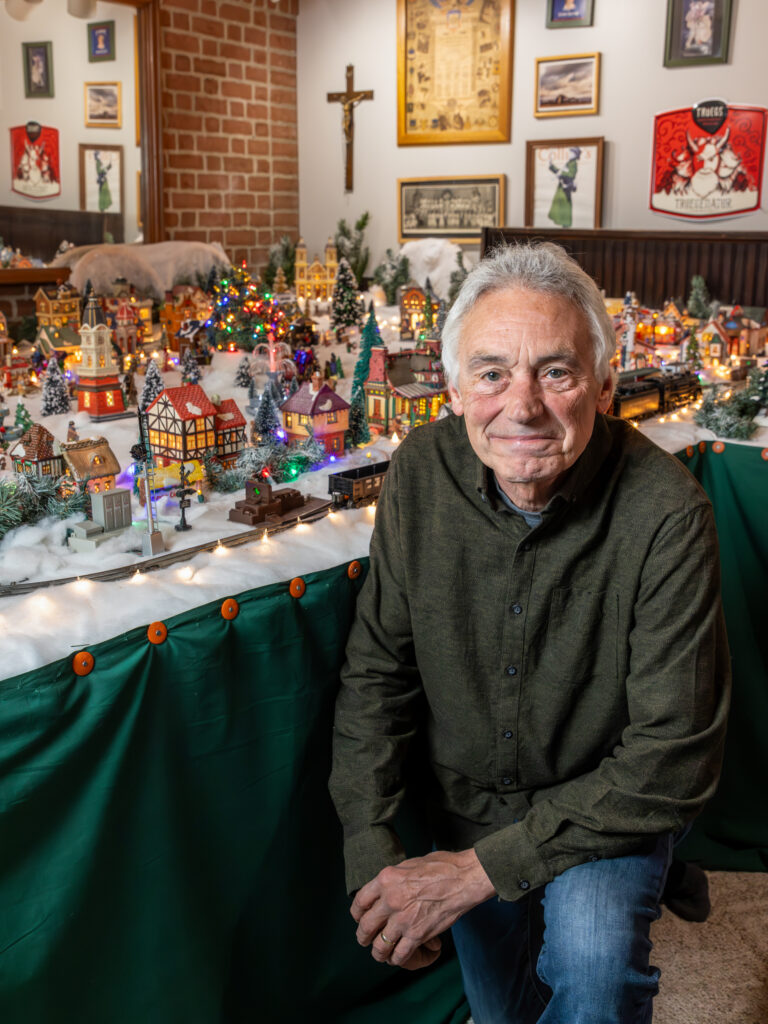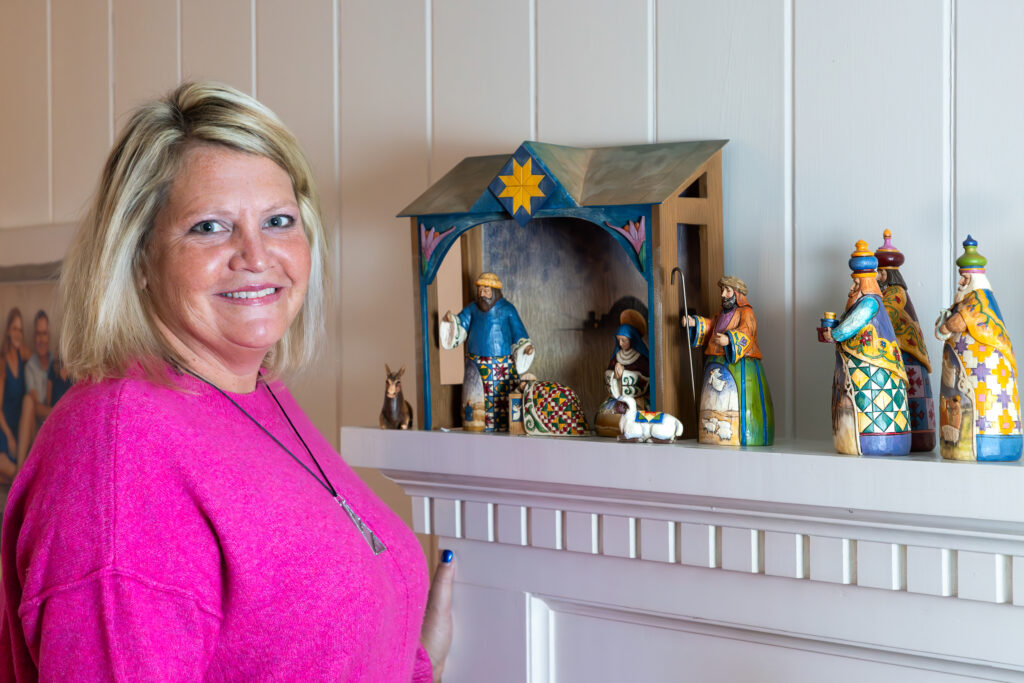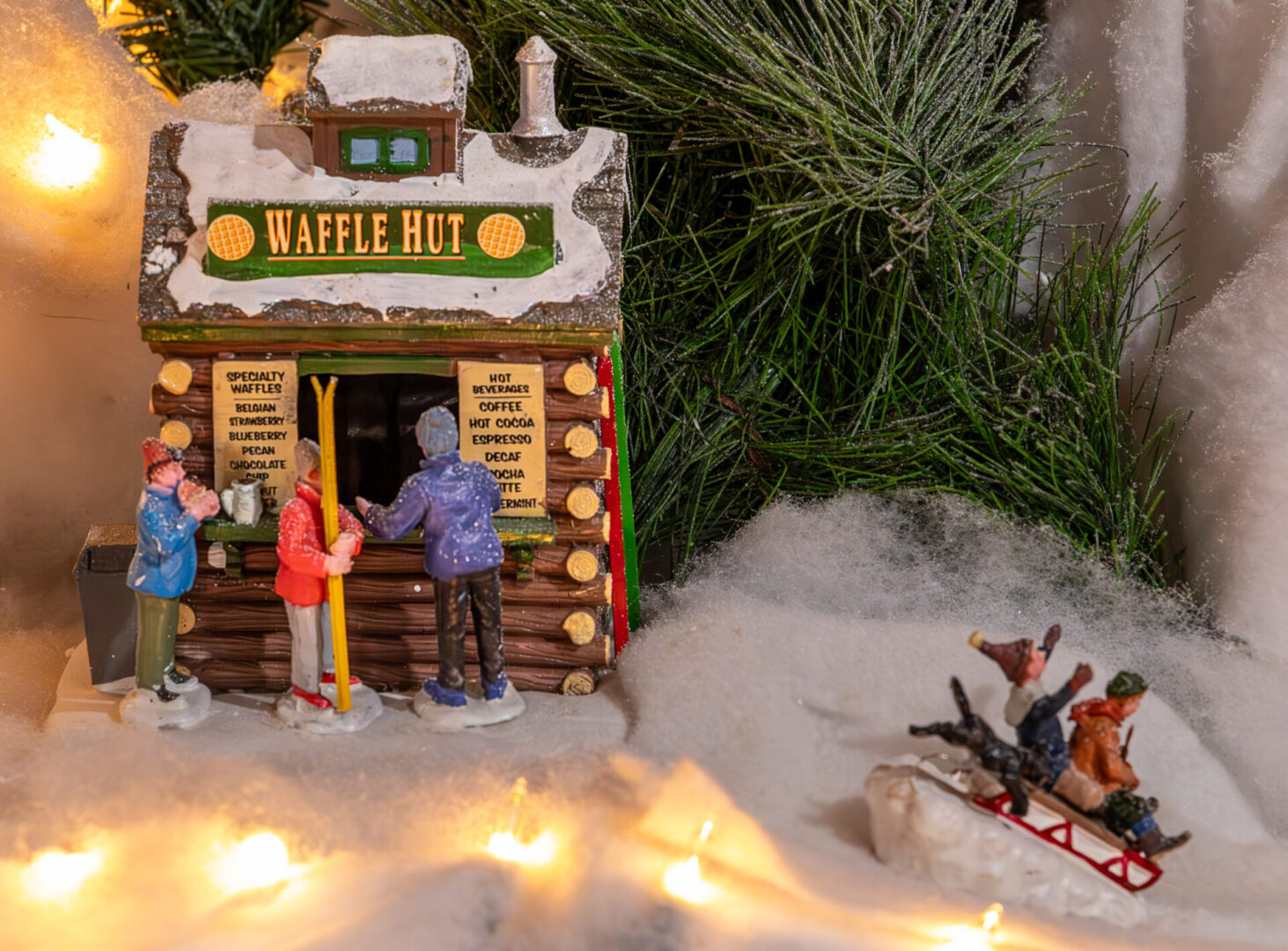Delights abound during the December holidays, a time of giving and gathering to celebrate traditions, family, faith, and fun. Holiday decorations and movies add sparkle, joy, and a touch of magic to the long December nights.
Some folks celebrate with a few decorations. Others go all out to create holiday wonderlands. And some collectors make Christmas the focus of their collecting.

A Christmas Village
Every Christmas, Dana Catalano transforms the basement of his State College home into a Christmas village, complete with trains.
He began thirty years ago. “My father-in-law set up a couple houses on a little table. And I set up a couple houses on my table.” The next year they added more.
Now Catalano has more than fifty illuminated buildings and 200 figurines. “It takes sixteen power strips and probably twenty power cords to get it all together so I can turn it on with one switch.”
He draws on his previous background as co-owner and president of Crider Construction and on his architecture degree to design and build the village on specially made tables.
He starts setting it up on October 1 and displays it until February. “I’ve never set it up twice the same.”
Putting it together takes six weeks—evenings and weekends. He establishes the pond and Tussey Mountain Ski Resort, then adds the trains and buildings, including the town center and a Christmas village with Santa.
“I like to add one piece a year—a wine shop this year. I’m trying to stay in a certain period. No fast food. Older cars and horse-drawn buggies.
“People love to see it. It puts them in a Christmas mood.”

Nativities & Santas
Beth Shaha is a life coach for The Grounded Canary and owns more than fifty nativities—three-dimensional sets, carved wooden wall hangings, and tree ornaments.
Shaha keeps one nativity with her throughout the year. “It was an ornament on my parents’ tree. … I have it here as a reminder of my faith.
“I even have one of Santa. It’s a carved Santa with his hands praying, looking down over a nativity scene. … That one is kind of special to me.”
Shaha’s first nativity set was a Lenox crystal wedding gift. She has Fontanini and Willow Tree nativity sets, and some from 10,000 Villages and the Faith Centre.
Her mother collected nativities and gave some to Shaha when she downsized.
After Thanksgiving, Shaha puts all of her nativities on display, along with her snowman collection. She keeps the nativities up until January, and the snowmen up until March so she has decorations after Christmas.
She currently looks for unique and interesting nativities that represent different cultures and places, including countries where she’s traveled—Mexico, Jamaica, Romania, and Germany.
“I do have a snowman nativity,” she says. “That goes away after Christmas.
“The quirkier, the more interesting, the better. I love it.”

Traditional Wooden German Ornaments
Renate Ferree and Irmgard Lee are friends and State College residents, originally from Germany, who collect traditional wooden German ornaments.
“It’s our heritage,” Lee says. She owns about thirty large, colorful nutcrackers and smokers (incense burners) from the Christian Ulbricht company in Seiffen, the famous toymaking town in Germany’s Ore Mountains. The Käthe Wohlfahrt company sells the ornaments at some Christmas markets in the U.S., and the ornaments are also available from the Steinbach company in West Germany.
Lee says the smokers and nutcrackers traditionally are for Christmastime, but now they are available for many more holidays. Smokers generally are made in the form of friendly people, she says. “Stern expressions are usually nutcrackers.”
Ferree has about fifty ornaments and decorations from Seiffen and has visited the town twice. She notes that, back when Seiffen’s silver mines were closing, the mining families shifted to painting wooden ornaments in their homes as a way to earn a living. “What impressed me was how they use their own knowledge, their own history, their own experience for this.”
Ferree’s miniature wooden decorations include nativities, towns, a troupe of miners, Christmas carolers, animals, and a church. An angel holding two candles symbolizes the opening of the mind.
“Some are stained or plain wood,” Ferree says. “Wood, in a way, is preferred—then it has to be good wood. If it’s not good, it’s painted over. Plain wood is more precious.
“A lot of my things are gifts,” she says. “A Christmas pyramid was the very first thing my parents gave me when I moved here in 1979.”
Her twenty-two-inch-tall, plain wooden pyramid has four levels of figurines—three with turntables—and a horizontal propeller on the top that spins with the heat of the lit candles along the sides.
“It’s most interesting how innovative they were in that little corner of the world,” Ferree says. “Before World War II, Woolworths had people there to buy things.”
A well-known five-and-dime store at the time, Woolworths sold the Christmas ornaments for an affordable price. Ferree inherited many tiny horse-drawn wagon toys from her mother-in-law, who bought them from Woolworths in the 1930s.
Since then, prices have risen. Lee says, “Collecting these kinds of things now is not a cheap Christmas.”

Vintage American Ornaments
Linda Wilson’s interest in World War II era Christmas ornaments was inspired by how her parents met during the war. He was a Marine with malaria, and she was a Navy nurse.
Working as an antiques dealer at Apple Hill Antiques, Wilson has found rare and interesting items to add to her own collections, including her pre- through post-World War II era American Christmas tree ornaments.
“I started out with Shiny Brite [glass balls], then German, then Czech, and Polish. I had to have an excuse to buy them. So I started giving talks. … I have enough Shiny Brite to decorate a tree.”
She has presented locally what she’s discovered about the impact of the war on these ornaments, and how to identify the different types. She says in the 1930s, Germany was the primary supplier of blown-glass Christmas ornaments. In 1939, Corning mass-produced the first American glass ball ornaments using a modified light bulb machine, so the war did not prevent Americans from decorating their trees.
From 1943 to 1945, all metal was needed for the war effort. Metal caps and hangers were replaced with cardboard. When paint use was restricted, the balls were striped or colorless, and some contained silvery pieces of tinsel. At the end of the war, people could buy colored cardboard ornaments covered in Venetian Dew, a layer of sparkly tiny glass balls. Wilson has collected examples of these rare ornaments, including some with intact cardboard caps and hangers.
She can identify the glass ball manufacturers from the shapes and embossed words on the metal caps. Shiny Brite has unique corrugated caps. Other brands have flat caps with scalloped or straight edges.
Her other collections include nativity sets, Christmas trees, dollhouses, and more.
“I just love antiques,” she says. “Collecting makes me happy.”
A Christmas Carol Movie Collection
IT professional Jim Carras collects movie versions of A Christmas Carol. “It’s been done so many different ways. I really like the traditional ones.
“What got me started was when I was growing up, I had a thirty-three LP [vinyl record]. One whole side of it was the narration of the Christmas Carol story. I used to play it all the time. I just always liked that story.”
He’s collected DVDs, VHS tapes, and electronic versions he buys online. “With DVDs and VHS tapes, I have to worry about having that equipment to see it, and technology changes. If I have it as a digital movie file, then I can essentially almost play it anywhere.”
Carras owns fourteen versions and has recently discovered more to collect. His current titles include animated films, a musical, comedies, and traditional dramas.
He grew up watching the 1951 Alastair Sim film. The 1938 version starring Reginald Owen is the oldest one he’s found. His modern favorites are the Patrick Stewart version (1999) and George C. Scott (1984).
He watches his favorites about two times a year. “If I see a copy, I need to view it or add it to my collection. … I just enjoy it.”
Holiday Nutcrackers
For Town&Gown’s own Madigan McGrath, advertising account executive, every nutcracker she collects is a gift.
It’s a mother-daughter tradition. Each year, her mother gives her a nutcracker and gives her sister a Santa, themed for milestones they achieved recently or activities they loved.
“I have twenty-one nutcrackers—will be twenty-two in December,” McGrath says. “I have an Irish one, a snowman, Mrs. Claus. … If a special event happened that year, she would try to get a corresponding nutcracker. The year I graduated from high school, she got me a graduate nutcracker.”
No one else in the family is a collector. “I just think this really stems from her wanting us to have a special thing from our childhood. She expressed that she didn’t have anything like memorabilia or tradition growing up so she wanted to start that for us.
“As a kid and even now I love receiving a nutcracker each year and being able to add to my collection. I definitely want to continue that.”
She doesn’t buy nutcrackers for herself.
“Right now, my mother and I want to keep the tradition as mother to daughter. One day when I have children, I would love to do something similar.” T&G
Karen Dabney is a freelance writer in State College.




